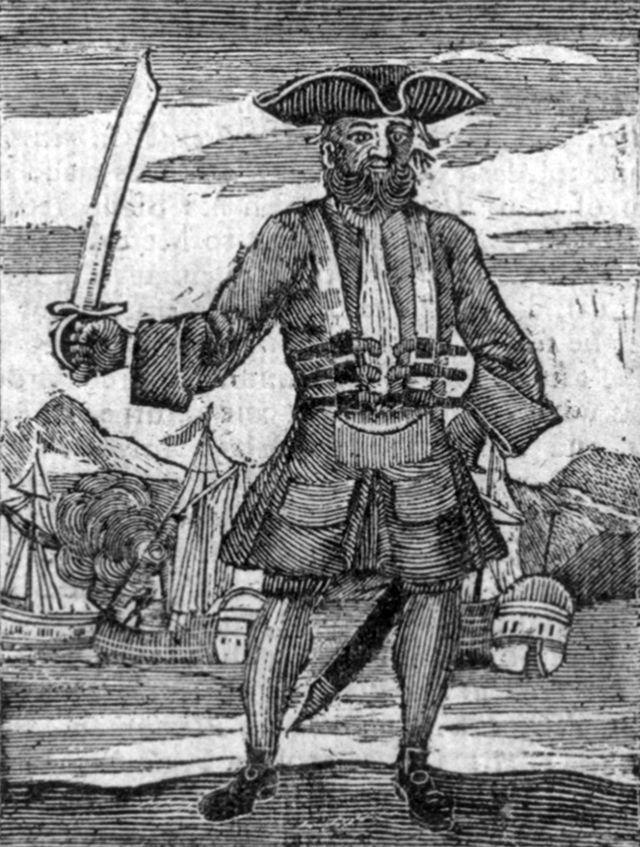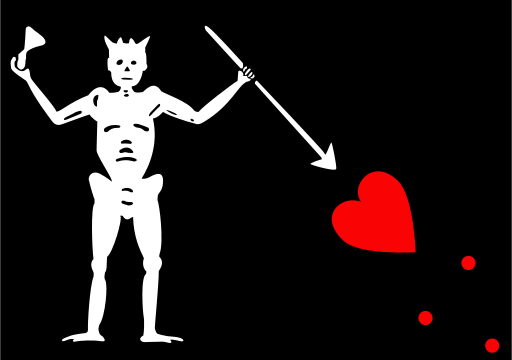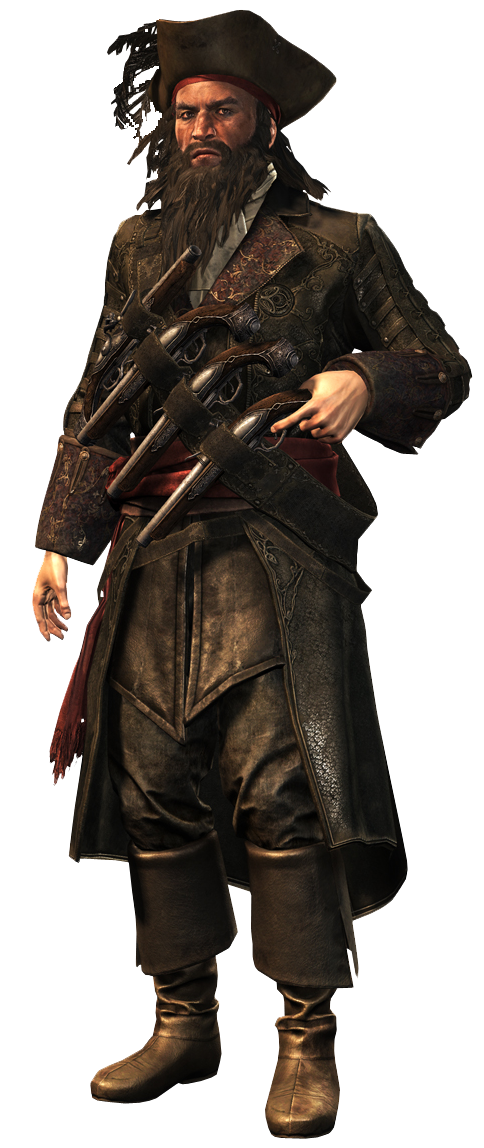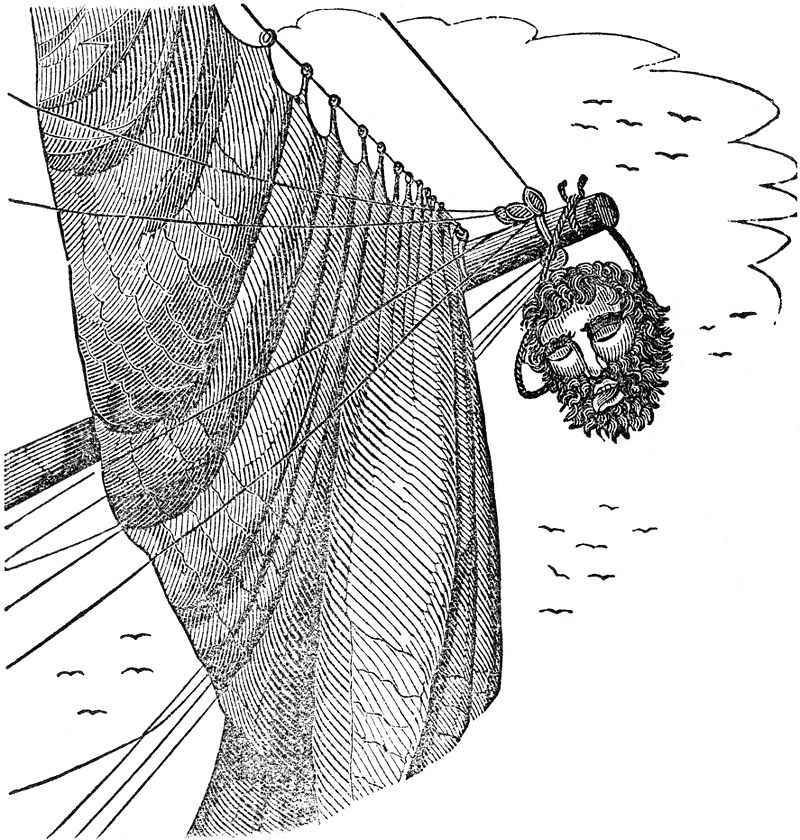 Blackbeard was one of the most famous pirates of all time. He was born in England in 1680 under the name Edward Drummond, but he later went by the name Edward Teach. During the War of Spanish Succession, known in the colonies as Queen Anne’s War, he operated as an English privateer based in Jamaica, attacking French and Spanish ships. When the war ended in 1717, he turned to outright piracy, primarily operating along the North American coastline.
Blackbeard was one of the most famous pirates of all time. He was born in England in 1680 under the name Edward Drummond, but he later went by the name Edward Teach. During the War of Spanish Succession, known in the colonies as Queen Anne’s War, he operated as an English privateer based in Jamaica, attacking French and Spanish ships. When the war ended in 1717, he turned to outright piracy, primarily operating along the North American coastline.
Early in his career, Blackbeard served under the pirate captain Benjamin Hornigold. Hornigold eventually gifted a captured sloop named Revenge to Teach, giving the famous pirate his first independent command. They worked together for some time, but eventually, the men on Hornigold’s ship voted to replace him as captain due to his reluctance to attack English vessels. This led to Blackbeard and Hornigold going their separate ways.
Blackbeard cultivated a reputation of ferocity, which he used to convince his targets to surrender without a fight. Many merchant ships would strike their colors at the mere mention of his name or the sight of his flag, fearing the stories of his violent nature. The name “Blackbeard” was itself a reference to his favorite intimidation tactic — in battle, he would stick slow-burning fuses into his large beard and light them, wreathing his head in smoke and creating the appearance of a demon from hell.

Blackbeard’s pirate flag.
Despite his fearsome reputation, Blackbeard preferred to avoid the actual use of force. He was usually lenient with his crew, and captured sailors were unharmed and treated with dignity. He preferred to use his frightening image to cow enemies into surrender, making his piracy easier and less deadly for all involved.
Blackbeard managed to raise a fleet of at least three ships, which he used to terrorize shipping throughout the northern Caribbean and the Atlantic. The most famous of these was his flagship, the Queen Anne’s Revenge. This was originally a frigate named La Concorde, which had been built in Britain before being captured by the French and converted into a slave ship. Blackbeard equipped this formidable vessel with 40 guns, and used it to project his power until the end of his career.
Blackbeard kept close ties with a number of other pirates. In early 1718, he encountered Stede Bonnet, an inexperienced landowner-turned-pirate. He sailed alongside Bonnet, and when he recognized the inexperience of his friend, he kept him aboard his flagship while taking command of his ship. He also hosted pirate parties, where other pirate captains and their crews would meet and drink together aboard Blackbeard’s vessels. The most well-known of these occurred in November 1718, when Blackbeard and the notorious Charles Vane spent several days drinking together. Vane attempted to convince him to bring back the glory days of the Pirate Republic with an invasion of Nassau, but Blackbeard refused.

Blackbeard in Assassin’s Creed IV.
Blackbeard’s largest coup was the blockade of Charleston harbor. In May 1718, his fleet arrived off the coast of South Carolina and proceeded to capture any shipping heading in or out of the port. Blackbeard’s pirates remained anchored outside the port for about a week. They captured a ship full of prominent citizens, and then demanded medical supplies from the city, threatening to execute the citizens if supplies were not provided. While the governor agreed, the pirates sent ashore did not return for several days, prompting Blackbeard to move his ships into harbor and inciting panic in the city. But they made it back just in time, and explained to Blackbeard that a number of the pirates had been hard to round up, as they had been busy getting drunk while ashore. True to his word, Blackbeard released the prisoners before departing with the medical supplies.
Near the end of 1718, Blackbeard accepted a royal pardon, along with Bonnet, who was still with his fleet. But Blackbeard betrayed both Bonnet and his men — he allowed Bonnet to go ashore ahead of him, while he remained behind and shipwrecked the Queen Anne’s Revenge, looted both it and Bonnet’s ship, and marooned 25 men who protested. He then went to Bath Town, North Carolina, and received a pardon himself. This action meant he was able to keep a greater portion of the captured loot for himself.
Blackbeard quickly returned to piracy despite his pardon, operating out of Ocracoke Island off the North Carolina coast. In response, a warrant was issued for his arrest. Two naval sloops under the command of Lieutenant Robert Maynard located him at Ocracoke and initiated a battle. Blackbeard sailed between two sandbars, tricking the sloops into beaching themselves, and obliterated one with a broadside from his cannons.
Blackbeard rammed Maynard’s remaining ship and his men boarded, but they were surprised when men hidden in the hold burst forth in ambush. Blackbeard and Maynard sough each other out and battled. They traded pistol shots — Blackbeard missed, but Maynard hit the pirate square in the chest. But rather than falling, Blackbeard remained steady and swung at Maynard with his cutlass, shattering the dumbfounded lieutenant’s sword in one blow.

Blackbeard’s head mounted on the bow of Maynard’s ship.
Maynard’s men saved him, closing in and slashing Blackbeard across the neck. Still the pirate fought on, but eventually he was overwhelmed by the numerous English sailors and eventually fell to the deck, dead. An examination of his body showed that the pirate had survived pistol shots and twenty cutlass blows. Maynard removed Blackbeard’s head and mounted it on his bow as proof of the notorious pirate’s death.
Because of Blackbeard’s reliance on his terrifying reputation and appearance, his stories were retold and romanticized after his death. His frequent appearances in modern media are a reflection of this. He figured most prominently in the 2011 film Pirates of the Caribbean 4: On Stranger Tides, in which Blackbeard searches for the fountain of youth. This film was based on an earlier novel, also named On Stranger Tides.
He has also appeared in a number of video games, most recently in Assassin’s Creed IV: Black Flag, in which he is shown to deliberately act frightening to his enemies. He appeared in the 2004 remake of Sid Meier’s Pirates! complete with his beard full of lit fuses, and frequently shows up as an enemy or persona in games that include named historical pirates, such as the Port Royale series and Tropico 2: Pirate Cove.
